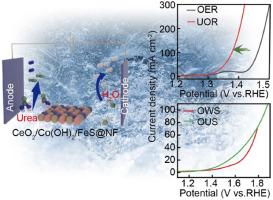构建 CeO2/Co(OH)2/FeS@NF 纳米片阵列,用于高性能电催化氧进化/尿素氧化以及整体水/尿素分离反应
IF 8.1
2区 工程技术
Q1 CHEMISTRY, PHYSICAL
引用次数: 0
摘要
开发具有高活性和稳定性的氧进化反应(OER)/尿素氧化反应(UOR)非贵金属电催化剂,对于提高整体水/尿素分离反应(OWS/OUS)生产 H2 的效率至关重要。在此,我们通过简单的两步水热法和溶热法在泡沫镍上合成了新型 CeO2/Co(OH)2/FeS 纳米片阵列(CeO2/Co(OH)2/FeS@NF)。在这种特殊的结构中,超薄的二维纳米片形态可以提供足够大的接触面积,从而提供丰富的活性位点,极大地促进了传质。此外,CeO2/Co(OH)2 中加入 FeS 不仅能改变电子结构,还能提供多个相界面,从而提高固有电子导电性,促进电子传输。更重要的是,丰富的氧空位(Ov)可改变金属中心的配位,调节电荷分布和 M-O 键强度。结果表明,CeO2/Co(OH)2/FeS@NF 与 OER/UOR 相比,在 10 mA cm-2 的过电位分别为 178 mV/1.30 V。即使电流密度增加到 300 mA cm-2 时,其活性仍保持在 232 mV/1.375 V 的低值。更重要的是,CeO2/Co(OH)2/FeS@NF//CeO2/Co(OH)2/FeS@NF 的电极只需要 1.41 V 的低电池电压,就能在 10 mA cm-2 的电流密度下实现 OUS。具体来说,我们还实现了太阳能驱动的 H2 生产。将太阳能电池板置于自然阳光下后,大量的 H2 气泡以 600 L h-1 m-2 的高速在工作电极表面不断生成。本文章由计算机程序翻译,如有差异,请以英文原文为准。

Construction of CeO2/Co(OH)2/FeS@NF nanosheet arrays for high-performance electrocatalytic oxygen evolution/urea oxidation, and overall water/urea splitting reactions
To develop non-noble electrocatalysts with high activity and stability for oxygen evolution reaction (OER)/urea oxidation reaction (UOR) is crucial to boost the efficiency of overall water/urea splitting reaction (OWS/OUS) for H2 production. Herein, we synthesized novel CeO2/Co(OH)2/FeS nanosheet arrays on nickel foam (CeO2/Co(OH)2/FeS@NF) through a simple two-step hydrothermal and following solvothermal routine. In this special structure, the ultra-thin 2D nanosheet morphology can adequately offer large contact area and thus abundant of active sites, facilitating significantly the mass transfer. Furthermore, the incorporation of FeS into CeO2/Co(OH)2 will not only modify the electron structure but also provide a number of phase interfaces, which can improve the inherent electron conductivity and promote the electron transport. More importantly, the rich oxygen vacancies (Ov) sites can vary the coordination of metal centers, modulating both the charge distribution and M−O bonding strength. As results, the CeO2/Co(OH)2/FeS@NF shows superior low overpotentials of 178 mV/1.30 V at 10 mA cm−2 to OER/UOR. The activity keeps its low value of 232 mV/1.375 V even when the current density was increased to as high as 300 mA cm−2. More importantly, the electrode of CeO2/Co(OH)2/FeS@NF//CeO2/Co(OH)2/FeS@NF just requires a low cell voltage of 1.41 V to realize OUS at a current density of 10 mA cm−2. Specifically, we also realized solar-driven H2 production. Plenty of H2 bubbles were continuously generated with a high speed of 600 L h−1 m−2 on the working electrode surface once the solar panel was placed under the natural sunlight.
求助全文
通过发布文献求助,成功后即可免费获取论文全文。
去求助
来源期刊

International Journal of Hydrogen Energy
工程技术-环境科学
CiteScore
13.50
自引率
25.00%
发文量
3502
审稿时长
60 days
期刊介绍:
The objective of the International Journal of Hydrogen Energy is to facilitate the exchange of new ideas, technological advancements, and research findings in the field of Hydrogen Energy among scientists and engineers worldwide. This journal showcases original research, both analytical and experimental, covering various aspects of Hydrogen Energy. These include production, storage, transmission, utilization, enabling technologies, environmental impact, economic considerations, and global perspectives on hydrogen and its carriers such as NH3, CH4, alcohols, etc.
The utilization aspect encompasses various methods such as thermochemical (combustion), photochemical, electrochemical (fuel cells), and nuclear conversion of hydrogen, hydrogen isotopes, and hydrogen carriers into thermal, mechanical, and electrical energies. The applications of these energies can be found in transportation (including aerospace), industrial, commercial, and residential sectors.
 求助内容:
求助内容: 应助结果提醒方式:
应助结果提醒方式:


